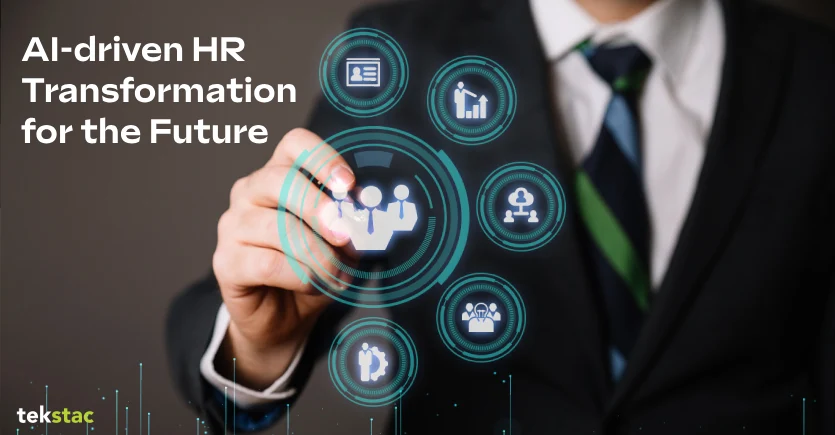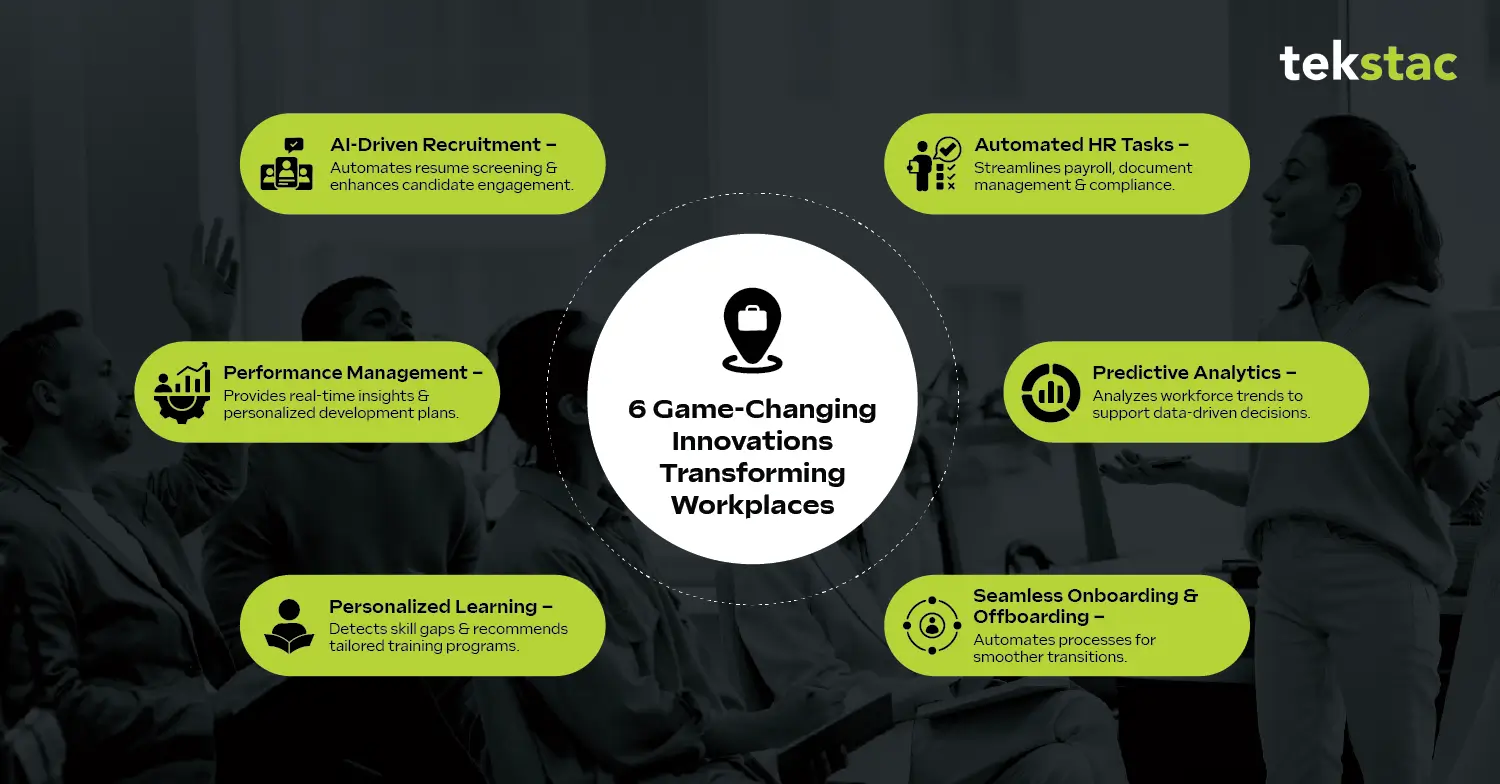HR Transformation: 6 Ways AI and Automation Drive Success

What is HR Transformation and Why It Matters?
76% of HR leaders agree that they risk falling behind in the next two years without AI.
As Generative AI (GenAI) and workforce digitization sweep across industries, HR transformation has become a critical priority. From digital HR strategy to next-gen workforce management, these technologies are reshaping traditional HR functions—adding both complexity and opportunity.
For organizations ready to adapt, the benefits of AI and automation in HR transformation are boundless: faster hiring, smarter decisions, and personalized employee growth. But for those who resist, the gap will only widen, making it essential to embrace these innovations today.
This article explores how AI and automation are driving HR transformation and why staying ahead is crucial for the future of work.
The Role of AI in HR Transformation
According to SHRM, about 1 in 4 organizations are currently using AI to support HR tasks. Nearly half of HR professionals said using AI to support HR has become a priority over the last year.
Here are six ways AI is transforming HR:
1. AI-driven recruitment revolution
Recruitment comes with inefficiencies for HR as they must review countless resumes while keeping candidates engaged throughout the hiring process. AI-powered applicant tracking systems (ATS) and talent intelligence platforms can now handle resume screening, ensuring that only the right fit reaches HR’s desk. This form of AI-powered talent management accelerates workforce planning and supports a digital-first HR transformation strategy.
Predictive analytics identify top talent faster, while AI chatbots maintain communication with candidates, keeping them engaged. Furthermore, generative AI platforms create personalized job descriptions and postings.
2. Redefined performance management
Traditional performance reviews and management are prone to bias and subjectivity, sometimes failing to reflect an employee’s work. AI now brings objectivity by analyzing employee performance in real-time. Machine learning algorithms identify performance patterns and suggest development plans for each employee. Repetitive tasks such as data collection are also automated, ensuring managers focus on employee career growth and meaningful conversations.
3. Personalized Learning and Development
With the rise of AI, HR can now customize learning journeys and track individual performance metrics to recommend training modules or upskilling initiatives. Any skills gaps are detected to provide targeted growth plans, ensuring employees grow in ways that benefit themselves and the organization. In the near future, AI has the potential to become a personal mentor for employees, providing invaluable career guidance.
4. Streamlined administrative HR tasks
HR teams are burdened by repetitive tasks like payroll processing, data management, and document management, leaving little time to interact with employees. AI-driven solutions automate these processes while being highly accurate and saving countless hours. For instance, payroll systems calculate and disburse salaries accurately, while document workflows ensure compliance without human intervention.
5. Enhanced decision-making with predictive analytics
AI can process and analyze data via predictive analytics, even presenting trends in areas like employee satisfaction, turnover rates, and diversity metrics. This empowers HR to anticipate challenges before they become devastating, and with seamless reporting features, HR can inform leaders to make data-driven decisions on workforce planning and management, thereby driving significant organizational change.
6. Efficient employee onboarding and offboarding
Onboarding can feel like finding your way through a maze of forms, policies, and processes, while offboarding has its challenges in compliance and security. AI simplifies both.
AI tailors workflows for each new hire during onboarding, automates benefits enrollment, and provides required training resources. It can also act as a virtual assistant, guiding end to end in onboarding . For offboarding, AI protects company data by managing automated equipment retrieval and ensuring smooth transitions with personalized communication.

How Automation Accelerates HR Transformation
Here’s how automation streamlines and transforms HR processes:
1. Effortless recruitment workflows
HR automation has transformed recruitment processes, enabling posting job ads across platforms in seconds, tracking applications in real-time, and even screening resumes effectively. Tasks like candidate ranking and interview scheduling are automated, enabling HR teams to focus on candidate experiences and finding the perfect fit.
2. Seamless onboarding experiences
From generating e-signed forms to granting access to essential tools and devices, automation creates a seamless journey for new hires. Automated workflows ensure nothing is missed—whether IT setups or mandatory training sessions—setting employees up for success from day one.
3. Simplified leave management
Submitting expenses is universally dreaded, and 1 in 5 manual expense reports are incorrect. Automation and AI-powered systems allow employees to snap a photo of their receipts, automatically extracting the necessary details like amount, date, and vendor. Approval workflows are initiated instantly, saving hours of back-and-forth emails. With countless hours of processing time saved, and errors practically eliminated, companies gain real-time expense visibility.
4. Error-free payroll processing
Manually managing payroll is prone to human errors, but automation brings accuracy and transparency to the forefront. It calculates from work hours to deductions and taxes, automating the entire payroll system to ensure that every paycheck is accurate and compliant. Not only does this save time, but it also builds trust among employees.
5. Smarter employee performance tracking
Forget tedious spreadsheets and inconsistent performance reviews. Automated systems now track employee performance metrics, offering real-time insights that empower managers to make informed decisions. Automation ensures unbiased evaluations, clear goal-setting, and actionable feedback loops.
HR Transformation and the Future of Employee Growth
As organizations embrace automation across HR processes, the need for more personalized solutions will arise—especially in learning and development.
The future of L&D lies in data-driven approaches that adapt to individual needs while driving organizational growth. AI-powered learning platforms like Tekstac offer game-changing features that help organizations evaluate and track skills effectively to empower employee growth.
How Tekstac Supports HR Transformation
With features like customizable assessments, dashboards with real-time analytics, and data-driven insights, these platforms simplify tracking skills progression and development plans. For instance, Tekstac provides:
- 500+ tailored learning paths
- Practice labs for hands-on experience
- AI-based integrity checks like proctoring and auto-evaluation
- Skills insights and business outcome dashboards
Ready to accelerate your HR Transformation journey? Tekstac’s AI-powered learning solutions are designed to future-proof your workforce.
FAQs on HR Transformation
1. What is HR transformation over the years?
HR transformation has evolved from administrative tasks to strategic, technology-driven initiatives using AI, analytics, and automation to enhance workforce efficiency and business outcomes.
2. Which HR processes benefit most from automation?
Recruitment, payroll, onboarding, performance tracking, and leave management benefit most from automation, reducing errors, saving time, and allowing HR teams to focus on strategy.
3. How does HR transformation improve employee experience?
HR transformation enhances employee experience by enabling personalized learning, streamlined onboarding, faster services, and data-driven decisions that build engagement, productivity, and long-term retention.
4. What role does learning and development play in HR transformation?
Learning and development fuels HR transformation by closing skills gaps, creating personalized growth paths, and aligning workforce capabilities with organizational goals for sustainable success.





